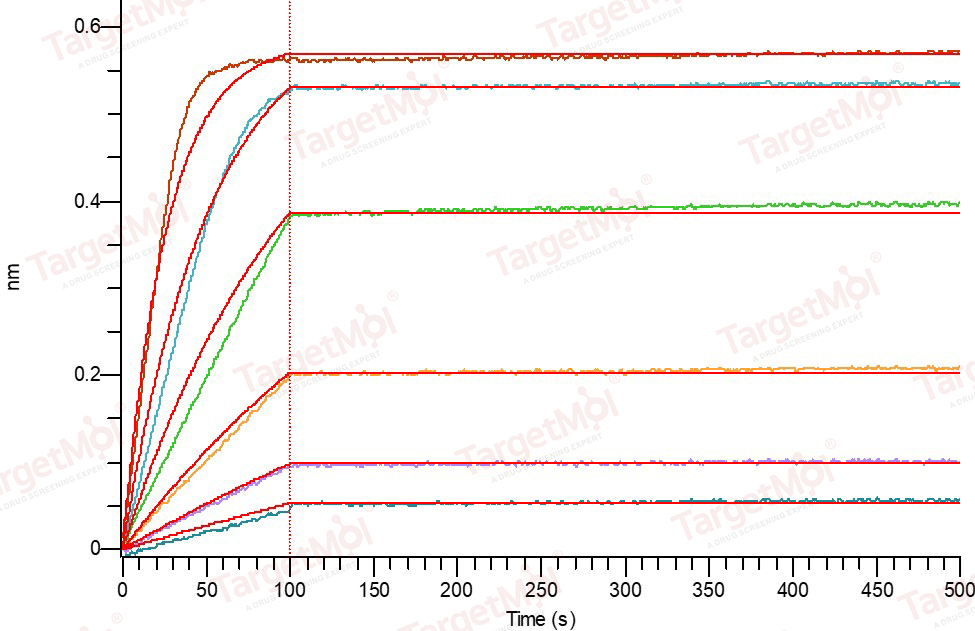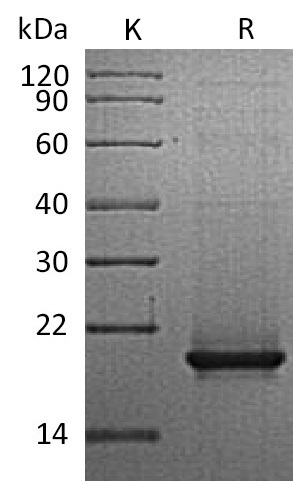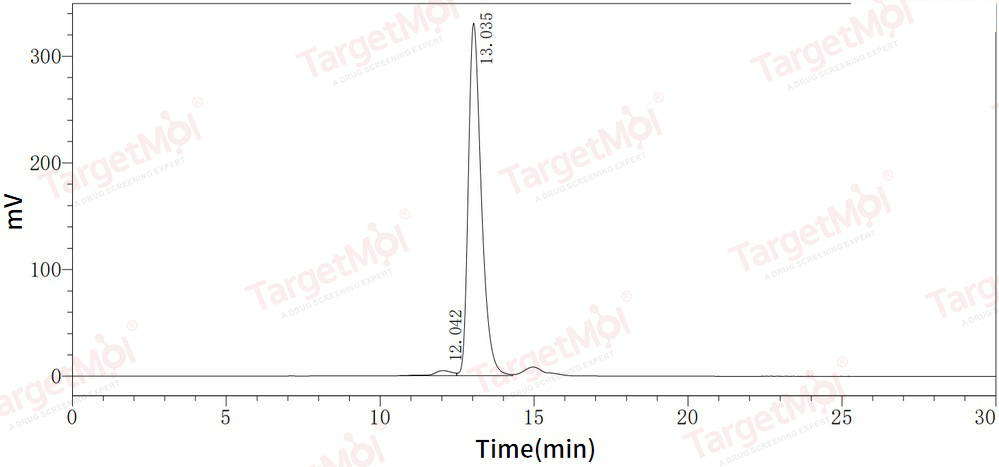- 全部删除
 您的购物车当前为空
您的购物车当前为空
RANKL/TNFSF11/CD254 Protein, Human, Recombinant (E. coli)
CD254, also known as RANKL, TNFSF11, TRANCE, OPGL and ODF, is a type II membrane protein of the tumor necrosis factor (TNF) superfamily, and affects the immune system and control bone regeneration and remodeling. RANKL is the ligand of nuclear factor (NF)-κB (RANK). When RANKL binds to RANK, it will undergo trimerization and then bind to an adaptor molecule TNF receptor-associated factor 6 (TRAF6). This results in the activation of several downstream signaling cascades, including the NFκB, mitogen-activated protein kinases (MAPK), activating protein 1 (AP-1), and nuclear factor of activated T cells (NFATc1), resulting in the formation of multinucleated bone-resorbing osteoclasts. RANKL is widely expressed in skeletal muscle, thymus, liver, colon, small intestine, adrenal gland, osteoblast, mammary gland epithelial cells, prostate and pancreas.

RANKL/TNFSF11/CD254 Protein, Human, Recombinant (E. coli)
| 规格 | 价格 | 库存 | 数量 |
|---|---|---|---|
| 10 μg | ¥ 1,170 | 现货 | |
| 50 μg | ¥ 3,470 | 5日内发货 | |
| 500 μg | ¥ 12,100 | 5日内发货 | |
| 1 mg | ¥ 17,400 | 5日内发货 |
产品信息
| 生物活性 | Loaded Recombinant Human OPG-Fc on Pro A Biosensor, can bind Human RANKL with an affinity constant of 1.83 pM as determined in BLI assay. (Regularly tested)  |
| 产品描述 | CD254, also known as RANKL, TNFSF11, TRANCE, OPGL and ODF, is a type II membrane protein of the tumor necrosis factor (TNF) superfamily, and affects the immune system and control bone regeneration and remodeling. RANKL is the ligand of nuclear factor (NF)-κB (RANK). When RANKL binds to RANK, it will undergo trimerization and then bind to an adaptor molecule TNF receptor-associated factor 6 (TRAF6). This results in the activation of several downstream signaling cascades, including the NFκB, mitogen-activated protein kinases (MAPK), activating protein 1 (AP-1), and nuclear factor of activated T cells (NFATc1), resulting in the formation of multinucleated bone-resorbing osteoclasts. RANKL is widely expressed in skeletal muscle, thymus, liver, colon, small intestine, adrenal gland, osteoblast, mammary gland epithelial cells, prostate and pancreas. |
| 种属 | Human |
| 表达系统 | E. coli |
| 标签 | Tag Free |
| 蛋白编号 | O14788 |
| 别名 | tumor necrosis factor ligand superfamily member 11,TNFSF11,Receptor activator of nuclear factor κ-B ligand,Receptor activator of nuclear factor kappa-B ligand,RANK L,Osteoclast differentiation factor,OPGL,ODF,CD254 |
| 氨基酸序列 | Ile140-Asp317 |
| 蛋白构建 | Ile140-Asp317 |
| 蛋白纯度 | Greater than 90% as determined by reducing SDS-PAGE. Greater than 90% as determined by SEC-HPLC.   |
| 分子量 | 20 KDa (reducing condition) |
| 内毒素 | < 0.1 ng/µg (1 EU/µg) as determined by LAL test. |
| 缓冲液 | Lyophilized from a solution filtered through a 0.22 μm filter, containing 20 mM Tris-HCl, 150 mM NaCl, pH 8.0. |
| 复溶方法 | Reconstitute the lyophilized protein in distilled water. The product concentration should not be less than 100 μg/ml. Before opening, centrifuge the tube to collect powder at the bottom. After adding the reconstitution buffer, avoid vortexing or pipetting for mixing. |
| 存储 | Lyophilized powders can be stably stored for over 12 months, while liquid products can be stored for 6-12 months at -80°C. For reconstituted protein solutions, the solution can be stored at -20°C to -80°C for at least 3 months. Please avoid multiple freeze-thaw cycles and store products in aliquots. |
| 运输方式 | In general, Lyophilized powders are shipping with blue ice. Solutions are shipping with dry ice. |
| 研究背景 | CD254, also known as RANKL, TNFSF11, TRANCE, OPGL and ODF, is a type II membrane protein of the tumor necrosis factor (TNF) superfamily, and affects the immune system and control bone regeneration and remodeling. RANKL is the ligand of nuclear factor (NF)-κB (RANK). When RANKL binds to RANK, it will undergo trimerization and then bind to an adaptor molecule TNF receptor-associated factor 6 (TRAF6). This results in the activation of several downstream signaling cascades, including the NFκB, mitogen-activated protein kinases (MAPK), activating protein 1 (AP-1), and nuclear factor of activated T cells (NFATc1), resulting in the formation of multinucleated bone-resorbing osteoclasts. RANKL is widely expressed in skeletal muscle, thymus, liver, colon, small intestine, adrenal gland, osteoblast, mammary gland epithelial cells, prostate and pancreas. |




